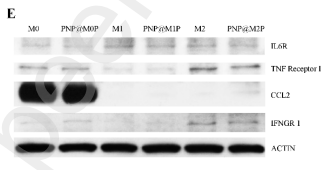IFNGR1 Antibody - #AF7734
| Product: | IFNGR1 Antibody |
| Catalog: | AF7734 |
| Description: | Rabbit polyclonal antibody to IFNGR1 |
| Application: | WB |
| Cited expt.: | WB |
| Reactivity: | Human, Mouse, Rat, Monkey |
| Prediction: | Pig, Zebrafish, Bovine, Horse, Sheep, Rabbit, Dog, Chicken |
| Mol.Wt.: | 50~100kD; 54kD(Calculated). |
| Uniprot: | P15260 |
| RRID: | AB_2844098 |
Related Downloads
Protocols
Product Info
*The optimal dilutions should be determined by the end user. For optimal experimental results, antibody reuse is not recommended.
*Tips:
WB: For western blot detection of denatured protein samples. IHC: For immunohistochemical detection of paraffin sections (IHC-p) or frozen sections (IHC-f) of tissue samples. IF/ICC: For immunofluorescence detection of cell samples. ELISA(peptide): For ELISA detection of antigenic peptide.
Cite Format: Affinity Biosciences Cat# AF7734, RRID:AB_2844098.
Fold/Unfold
Antiviral Protein Type II; Antiviral protein, type 2; AVP type II; AVP, type 2; CD 119; CD119; CD119 antigen; CDw119; FLJ45734; IFN gamma R alpha; IFN gamma R; IFN gamma R1; IFN-gamma receptor 1; IFN-gamma-R1; IFNG R1; IFNGR 1; IFNGR; IFNGR1; Immune interferon receptor 1; Immune interferon receptor for; INGR1_HUMAN; Interferon gamma receptor 1; Interferon gamma receptor alpha chain; Interferon gamma receptor alpha chain precursor;
Immunogens
A synthesized peptide derived from human Interferon gamma Receptor 1, corresponding to a region within C-terminal amino acids.
- P15260 INGR1_HUMAN:
- Protein BLAST With
- NCBI/
- ExPASy/
- Uniprot
MALLFLLPLVMQGVSRAEMGTADLGPSSVPTPTNVTIESYNMNPIVYWEYQIMPQVPVFTVEVKNYGVKNSEWIDACINISHHYCNISDHVGDPSNSLWVRVKARVGQKESAYAKSEEFAVCRDGKIGPPKLDIRKEEKQIMIDIFHPSVFVNGDEQEVDYDPETTCYIRVYNVYVRMNGSEIQYKILTQKEDDCDEIQCQLAIPVSSLNSQYCVSAEGVLHVWGVTTEKSKEVCITIFNSSIKGSLWIPVVAALLLFLVLSLVFICFYIKKINPLKEKSIILPKSLISVVRSATLETKPESKYVSLITSYQPFSLEKEVVCEEPLSPATVPGMHTEDNPGKVEHTEELSSITEVVTTEENIPDVVPGSHLTPIERESSSPLSSNQSEPGSIALNSYHSRNCSESDHSRNGFDTDSSCLESHSSLSDSEFPPNNKGEIKTEGQELITVIKAPTSFGYDKPHVLVDLLVDDSGKESLIGYRPTEDSKEFS
Predictions
Score>80(red) has high confidence and is suggested to be used for WB detection. *The prediction model is mainly based on the alignment of immunogen sequences, the results are for reference only, not as the basis of quality assurance.
High(score>80) Medium(80>score>50) Low(score<50) No confidence
Research Backgrounds
Associates with IFNGR2 to form a receptor for the cytokine interferon gamma (IFNG). Ligand binding stimulates activation of the JAK/STAT signaling pathway. Plays an essential role in the IFN-gamma pathway that is required for the cellular response to infectious agents.
Phosphorylated at Ser/Thr residues.
Cell membrane>Single-pass type I membrane protein.
Belongs to the type II cytokine receptor family.
Research Fields
· Cellular Processes > Cell growth and death > Necroptosis. (View pathway)
· Environmental Information Processing > Signaling molecules and interaction > Cytokine-cytokine receptor interaction. (View pathway)
· Environmental Information Processing > Signal transduction > HIF-1 signaling pathway. (View pathway)
· Environmental Information Processing > Signal transduction > Jak-STAT signaling pathway. (View pathway)
· Human Diseases > Infectious diseases: Bacterial > Salmonella infection.
· Human Diseases > Infectious diseases: Parasitic > Leishmaniasis.
· Human Diseases > Infectious diseases: Parasitic > Chagas disease (American trypanosomiasis).
· Human Diseases > Infectious diseases: Parasitic > Toxoplasmosis.
· Human Diseases > Infectious diseases: Bacterial > Tuberculosis.
· Human Diseases > Infectious diseases: Viral > Measles.
· Human Diseases > Infectious diseases: Viral > Influenza A.
· Human Diseases > Infectious diseases: Viral > Herpes simplex infection.
· Human Diseases > Cancers: Overview > Pathways in cancer. (View pathway)
· Human Diseases > Immune diseases > Inflammatory bowel disease (IBD).
· Organismal Systems > Development > Osteoclast differentiation. (View pathway)
· Organismal Systems > Immune system > Natural killer cell mediated cytotoxicity. (View pathway)
· Organismal Systems > Immune system > Th1 and Th2 cell differentiation. (View pathway)
· Organismal Systems > Immune system > Th17 cell differentiation. (View pathway)
References
Application: WB Species: Mouse Sample:
Restrictive clause
Affinity Biosciences tests all products strictly. Citations are provided as a resource for additional applications that have not been validated by Affinity Biosciences. Please choose the appropriate format for each application and consult Materials and Methods sections for additional details about the use of any product in these publications.
For Research Use Only.
Not for use in diagnostic or therapeutic procedures. Not for resale. Not for distribution without written consent. Affinity Biosciences will not be held responsible for patent infringement or other violations that may occur with the use of our products. Affinity Biosciences, Affinity Biosciences Logo and all other trademarks are the property of Affinity Biosciences LTD.


